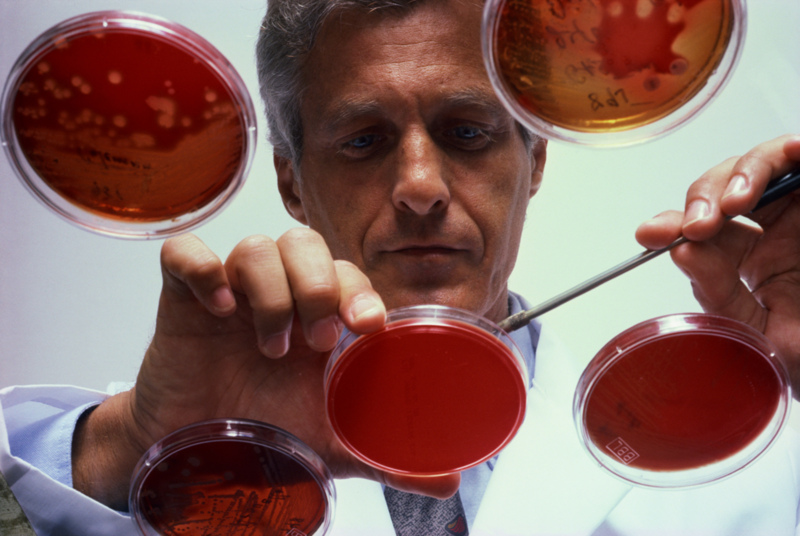Stay Informed
Popular Articles
- Hiatal Hernia: Hidden Cause of Chronic Illness
- Small Intestinal Bacterial Overgrowth (SIBO)
- Applied Lymphology: Unlocking the Secret to Pain Relief
- An Introduction to Constitutional Iridology
- The Low Down on Liver Detoxification
- An Energetic and Emotional Approach to Cancer
- Fat Facts
- Marrow in the Bones
- Blood Type and Nutrition
- Cardiac Herbs: Beyond Hawthorn
Quick Search
The School of Modern Herbal Medicine




The Trouble with Antibiotics
- 2/9/2008
- Categorized in: Specific Health Problems
 This is a two part article. Be sure to read the second part: A Comprehensive Approach to Infection
This is a two part article. Be sure to read the second part: A Comprehensive Approach to Infection
An antibiotic is a chemical compound that inhibits or abolishes the growth of microorganisms. “Anti” means against and “biotic” means life, so antibiotic literally means “against life,” an interesting observation considering the “war” mind-set out of which antibiotics grow. (I'll explain more about this later.)
Most antibiotics are anti-bacterial and do not have activity against viruses, fungi, or other microbes. Anti-bacterial antibiotics can be categorized based on their target specificity: “narrow-spectrum” antibiotics target particular types of bacteria, such as Gram-negative or Gram-positive bacteria, while broad-spectrum antibiotics affect a wide range of bacteria.
The first antibiotic compounds used in modern medicine were produced and isolated from living organisms; for example, penicillin is produced by fungi in the genus Penicillin. Penicillin first became widely used in World War II, where it was used to treat infected wounds—a reasonable use of the drug.
Unfortunately, antibiotics have been seriously overused for conditions where they have little or no effect. They are fed to animals for “prevention” of infection or more likely as a means of offsetting unsanitary living conditions for animals. In humans, they are prescribed for conditions for which they have little or no effect, such as colds, sore throats and earaches.
Problems with Antibiotics
There are two main problems with the indiscriminate use of antibiotics. First, by killing friendly bacteria in the colon, broad-spectrum antibiotics allow yeast and other unfriendly microbes to multiply out of control, which causes intestinal inflammation, leaky gut syndrome and a weakening of the immune system. Second, bacteria develop a resistance to antibiotics, so the longer they are used, the tougher bacteria become to kill. This leads to antibiotic resistant infections, which have sometimes been called “superbugs.”
Antibiotic resistance for penicillin started within four years of its introduction. This is why new antibiotics have to be constantly developed. Most modern antibiotics don't come from living things, they are synthetic compounds and even these synthetic compounds are starting to fail. Highly resistant and virulent microbes have now become a worldwide problem, primarily in hospitals and medical clinics. Joe Cranston, PhD, Director of the Dept of Drug Policy and Standards of the American Medical Association stated, “Whenever antibiotics are used, there is selective pressure for resistance to occur. It builds upon itself.”
Clearly, the need to look for alternative methods of fighting infection is a real one. But, before we address natural alternatives to antibiotics, let's first consider the whole “anti” mindset.
The Germ Theory
Growing up, I accepted the “germ theory” without question. Public education taught me that colds, flu, sore throats, chicken pox, measles and a host of other diseases were caused by bacteria and viruses. My mother dutifully took me to the doctor each time I was sick, who prescribed penicillin for me. At the age of 14, he diagnosed me with chronic sinusitis and put me on a daily dose of penicillin for two years. Two years later, my sinus problems were worse than ever. This was probably due to increasing weakness of the immune system due to yeast overgrowth and to the bacterial resistance I had developed to the antibiotics.
As I began to look for alternatives, I learned the “biological terrain” theory. I learned that the weakened diseased tissues in my body were “hosts” for microbes. The idea entered my head that germs were like flies and my damaged tissues were like a garbage pile. I could kill the flies, but if I didn't remove the garbage the flies would be back as soon as the pesticide wore off. So, I began a slow process of eating more natural foods and detoxifying my body.
It worked and I got better. Thus, I swore off antibiotics (and the germ theory) and embraced the biological terrain concept. It has served me well. I have focused on changing the terrain rather than worrying about infection, even though I use the “war” language of the germ theory sometimes because it takes so long to explain the concept of biological terrain to people.
Germs Do Play a Role in Disease
 Recently, however, I've begun to rethink my position on germs a little. It started when I read a book called 1491, which put forth new archeological evidence of what the Americas were like before Columbus. Apparently, the Americas were very densely populated at the time of Columbus and in some ways, Native Americans were stronger (and healthier) than their European contemporaries. Also, they were not so unevenly matched in technology. For example, Native American bows and arrows could shoot farther and with more accuracy than European guns.
Recently, however, I've begun to rethink my position on germs a little. It started when I read a book called 1491, which put forth new archeological evidence of what the Americas were like before Columbus. Apparently, the Americas were very densely populated at the time of Columbus and in some ways, Native Americans were stronger (and healthier) than their European contemporaries. Also, they were not so unevenly matched in technology. For example, Native American bows and arrows could shoot farther and with more accuracy than European guns.
In diet and hygiene, the Native Americans were actually ahead of the Europeans. In fact, early explorers to the Americans couldn't understand why Native Americans bathed every day, as Europeans at the time had very poor hygiene and were reluctant to bathe once a week. Early Native Americans complained the Europeans were “dirty.”
Native Americans also had a better diet, partly due to a better developed system of agriculture. Native Americans had spent generations perfecting a wide variety of food crops, including: corn, beans, squash, potatoes, tomatoes, both sweet and hot peppers, sunflowers, zucchini, peanuts, sweet potatoes, chocolate, vanilla, tapioca, avocado and many more. Since these foods are now cultivated and used in cuisines on every continent, it is easy to forget that all of these foods were developed by Native Americans.(1)
But, I digress from my major point. What enabled Europeans to conquer the Americas was not superior technology, but their own lack of good sanitation. The Europeans brought germs to America that Native Americans had never encountered and to which they had no immunity. Archeologists are discovering that 90% of the population of North and South America was wiped out by diseases like small pox, measles, chicken pox, etc. The devastation left in the wake of these plagues was what allowed the European settlers to gain a foothold. In other words, the only reason there was a place for the Pilgrims to land and settle without being wiped out by Native Americans was that a plague had gone through the year before and wiped out most of the inhabitants of the region. (2)
This book really got me to thinking about my adamant belief in the biological terrain theory. After all, the Native Americans were a fairly healthy people, living on good food and in an environment free of chemical toxins. If the biological terrain theory was completely true, then why weren't they immune to the microbes brought by European explorers? Perhaps, I thought, as with so many other things, I'd swung too far to the opposite end and that the truth lies somewhere in between.
I remember Edward Milo Millet (my first herb teacher) saying once that antibiotics are necessary sometimes. He said that once a forest fire gets going it will burn green wood as well as the dry, dead material. Since that time, I've learned that multiplying germs produce toxins and that these toxins are what really causes the destruction associated with infection. So, from what I understand, disease microbes find a suitable terrain in the body and start multiplying. As they feed and multiply, they create a toxic environment that damages nearby healthy tissue creating a larger environment for them to grow. Yeast appears to do this as it secretes a toxin that makes a person crave sugar, which, in turn feeds the growth of the yeast.
So, what if both theories are correct? What if infectious disease is partly caused by germs and partly caused by terrain? If so, then a sensible approach to infection is to work on controlling the microbes and enhancing the biological terrain. We'll discuss this in the second part of this article: A Comprehensive Approach to Infection
_______________________
(1) If you want to read more about this, let me recommend the book: Indian Givers: How the Indians of the Americas Transformed the World by Jack Weatherford. If you read it, you'll discover that Native American technology and culture transformed the world, not just in food, but also in wealth, medicine, government and other fields. You'll never see Native Americans as primitive savages again.
(2) If you are interested in reading the evidence for these assertions, read 1491: New Revelations of the Americas Before Columbus by Charles C. Mann.
